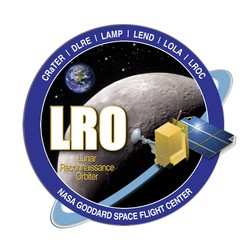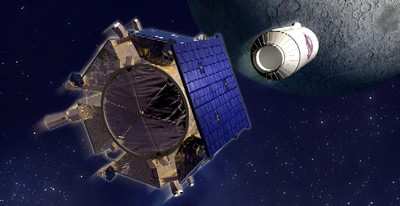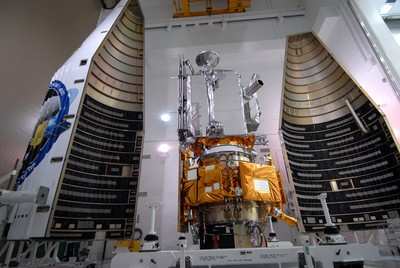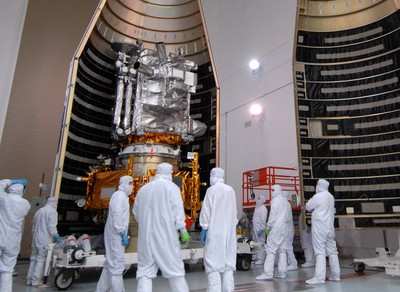 NASA's return to the moon will get a
boost in June with the launch of two satellites that will return a
wealth of data about Earth's nearest neighbor. On Thursday, the
agency outlined the upcoming missions of the Lunar Reconnaissance
Orbiter, or LRO, and the Lunar Crater Observation and Sensing
Satellite, or LCROSS. The spacecraft will launch together June 17
aboard an Atlas V rocket from Cape Canaveral Air Force Station in
Florida.
NASA's return to the moon will get a
boost in June with the launch of two satellites that will return a
wealth of data about Earth's nearest neighbor. On Thursday, the
agency outlined the upcoming missions of the Lunar Reconnaissance
Orbiter, or LRO, and the Lunar Crater Observation and Sensing
Satellite, or LCROSS. The spacecraft will launch together June 17
aboard an Atlas V rocket from Cape Canaveral Air Force Station in
Florida.
Using a suite of seven instruments, LRO will help identify safe
landing sites for future human explorers, locate potential
resources, characterize the radiation environment and test new
technology. LCROSS will seek a definitive answer about the presence
of water ice at the lunar poles. LCROSS will use the spent second
stage Atlas Centaur rocket in an unprecedented way that will
culminate with two spectacular impacts on the moon's surface.
"These two missions will provide exciting new information about
the moon, our nearest neighbor," said Doug Cooke, associate
administrator of NASA's Exploration Systems Mission Directorate in
Washington. "Imaging will show dramatic landscapes and areas of
interest down to one-meter resolution. The data also will provide
information about potential new uses of the moon. These teams have
done a tremendous job designing and building these two
spacecraft."
LRO's instruments will help scientists compile high resolution,
three-dimensional maps of the lunar surface and also survey it in
the far ultraviolet spectrum. The satellite's instruments will help
explain how the lunar radiation environment may affect humans and
measure radiation absorption with a plastic that is like human
tissue.

LRO's instruments also will allow scientists to explore the
moon's deepest craters, look beneath its surface for clues to the
location of water ice, and identify and explore both permanently
lit and permanently shadowed regions. High resolution imagery from
its camera will help identify landing sites and characterize the
moon's topography and composition. A miniaturized radar will image
the poles and test the system's communications capabilities.
"LRO is an amazingly sophisticated spacecraft," said Craig
Tooley, LRO project manager at NASA's Goddard Space Flight Center
in Greenbelt, Md. "Its suite of instruments will work in concert to
send us data in areas where we've been hungry for information for
years."

While most Centaurs complete their work after boosting payloads
out of Earth's orbit, the LCROSS Centaur will journey with the
spacecraft for four months and be guided to an impact in a
permanently shadowed crater at one of the moon's poles. The
resulting debris plume is expected to rise more than six miles. It
presents a dynamic observation target for LCROSS as well as a
network of ground-based telescopes, LRO, and possibly the Hubble
Space Telescope. Observers will search for evidence of water ice by
examining the plume in direct sunlight. LCROSS also will increase
knowledge of the mineralogical makeup of some of the remote polar
craters that sunlight never reaches. The satellite represents a new
generation of fast development, cost capped missions that use
flight proven hardware and off the shelf software to achieve
focused mission goals.
"We look forward to engaging a wide cross section of the public
in LCROSS' spectacular arrival at the moon and search for water
ice," said LCROSS Project Manager Dan Andrews of NASA's Ames
Research Center at Moffett Field, Calif. "It's possible we'll learn
the answer to what is increasingly one of planetary science's most
intriguing questions."
LRO and LCROSS are the first missions launched by the
Exploration Systems Mission Directorate. Their data will be used to
advance goals of future human exploration of the solar system. LRO
will spend at least one year in low polar orbit around the moon,
collecting detailed information for exploration purposes before
being transferred to NASA's Science Mission Directorate to continue
collecting additional scientific data.

Goddard manages the Lunar Reconnaissance Orbiter. Ames manages
the Lunar Crater Observation and Sensing Satellite. LRO is a NASA
mission with international participation from the Institute for
Space Research in Moscow. Russia provides the neutron detector
aboard the spacecraft. Northrop Grumman in Redondo Beach, Calif.,
built the LCROSS spacecraft.
 Sierra Space Repositions Dream Chaser for First Mission
Sierra Space Repositions Dream Chaser for First Mission ANN's Daily Aero-Term (05.10.24): Takeoff Roll
ANN's Daily Aero-Term (05.10.24): Takeoff Roll Aero-News: Quote of the Day (05.10.24)
Aero-News: Quote of the Day (05.10.24) Aero-News: Quote of the Day (05.11.24)
Aero-News: Quote of the Day (05.11.24) ANN's Daily Aero-Term (05.11.24): IDENT Feature
ANN's Daily Aero-Term (05.11.24): IDENT Feature






